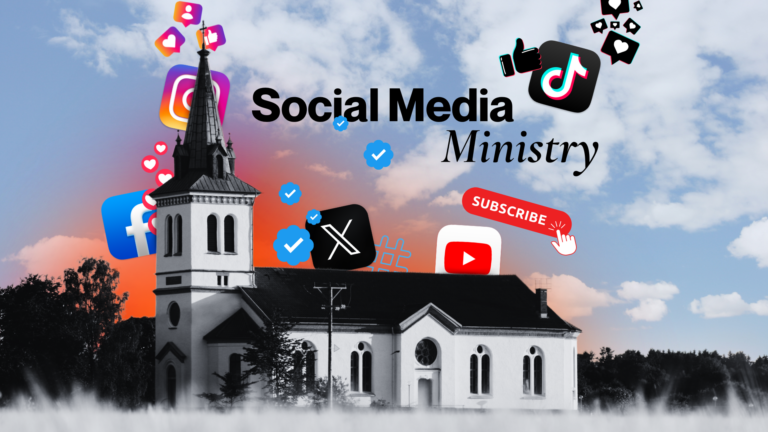Feeling overwhelmed by the ever-changing landscape of social media? You’re not alone. As more churches embrace digital platforms, the idea of a “Social Media Ministry” is becoming crucial. It’s not just about posting Sunday services online; it’s about engaging with your community, building connections, and extending your church’s reach like never before. With effective online communication, your church can amplify its message beyond traditional boundaries, attracting new members and reinforcing relationships with current ones. This post will guide you through practical steps to make your church’s message resonate in the bustling world of social media. Get ready to see your church’s influence grow.
Understanding Social Media Ministry
As the world spins faster and faster in the digital space, our connection with each other and with our faith community doesn’t have to fall behind. Social Media Ministry offers a unique pathway to bring the church to people wherever they are—whether that’s in the comfort of their living room or on their way to work. This section helps you grasp the essence of blending spirituality with online engagement.
The Purpose of Social Media in the Church
Why should a church venture into the social media landscape? By stepping into this vibrant space, churches can achieve several key goals:
-
Outreach: Social media breaks down walls, reaching people who might never walk through a physical church door. It’s an opportunity to spread messages of hope, faith, and love to broader audiences.
-
Community Building: Social media isn’t just about getting likes or shares; it’s about creating a sense of belonging. Church members can connect, share stories, and support each other, building a stronger, more united community.
-
Spiritual Growth: Encouraging spiritual growth through daily verses, inspirational posts, and virtual Bible studies can help members deepen their faith journey. Social media makes it easier for people to access spiritual resources on the go.
Think of social media as the modern megaphone where each post amplifies your church’s message, resonating with a congregation that’s not bound by physical walls.
Statistics on Social Media Usage
Before diving into strategies, it’s handy to understand the sheer power and influence of social media. Here are some eye-opening statistics:
-
Global Reach: As of 2023, over 4.9 billion people are active on social media. That’s more than half the planet! Each of these individuals is a potential receiver of your church’s message.
-
Youth Engagement: About 84% of teens and young adults are on platforms like Instagram and TikTok. If reaching younger demographics is part of your mission, these are the channels where they engage most.
-
Daily Use: On average, internet users spend around 2 hours and 31 minutes per day on social media. This represents countless opportunities for the church to touch lives and inspire followers throughout their day.
With stats like these, leveraging social media is no longer just an option; it’s a crucial component of any ministry looking to thrive in today’s connected world. By understanding these stats, you can better tailor your approach to reach hearts and minds effectively.
Strategies for Effective Social Media Ministry
In today’s digital landscape, Social Media Ministry is more important than ever for amplifying your church’s message and reaching a broader audience. With thoughtful strategies, you can transform online interactions into meaningful connections. Let’s explore how to make your church’s voice heard through engaging content and a smart platform strategy.
Creating Engaging Content
Crafting captivating social media posts isn’t just about what you say—it’s how you say it. Engaging content speaks to the heart and invites followers to join the conversation. Here’s how you can make your posts stand out:
-
Visuals Matter: Use eye-catching photos, videos, and graphics. A stunning image of a Sunday service or a serene sunset can capture attention and convey the spirit of your message without a single word.
-
Tell a Story: Every church has stories to tell. Share testimonies, community service highlights, or the journey of a church project. Stories create emotional connections and provide depth to your ministry’s mission.
-
Include Calls to Action: Engage your audience with a clear invitation. Whether it’s to “join us this Sunday,” “leave a comment,” or “share this with a friend,” make sure every post encourages interaction. It’s like extending an open hand to keep the dialogue going.
Think of your social media posts as seeds you’re planting. Over time, they grow into a vibrant community dialogue that reflects your church’s values and message.
Utilizing Different Platforms
Not all social media platforms are created equal. Each has unique strengths that can be leveraged to tailor your church’s message effectively. Here’s a breakdown of the most popular platforms and how to use them for your Social Media Ministry:
-
Facebook: Ideal for building community and fostering discussions. Use it to create groups for Bible study or events, and share longer posts that invite comments and shares.
-
Instagram: A visual-first platform that’s perfect for showcasing church life through images and stories. Use hashtags to reach wider audiences, and don’t forget to post behind-the-scenes glimpses of church events.
-
Twitter: Great for quick updates, sharing inspirational quotes, or engaging in trending conversations. Use it to broadcast timely church announcements or reflections on current events in just a few words.
Adjusting your content style to fit each platform is like tailoring a suit—it ensures your message fits well and looks great wherever it’s seen. Ensure your church’s voice is consistent, yet flexible, adapting to the strengths of each platform to maximize reach and engagement.
By focusing on engaging content and utilizing the unique strengths of various platforms, your church can expand its influence and connect with people in meaningful ways. Embrace the power of Social Media Ministry and let your message shine online.
Building a Community Online
Creating a vibrant online community is an essential part of any successful social media ministry. It’s where your church’s message comes alive in engaging conversations, shared experiences, and meaningful connections. But how do you foster such an environment? Let’s explore some effective strategies.
Encouraging Interaction and Engagement
One of the top priorities in building a community is encouraging your followers to interact. Think about it as hosting a gathering at your home. You want to make everyone feel welcome so they’re comfortable enough to chat and share their own stories. Here are a few ways to do that online:
-
Ask Questions: If you want engagement, start with open-ended questions related to your posts. Questions invite people to share their experiences or thoughts, sparking a conversation. For instance, after a Sunday sermon video, ask your audience, “How do you apply this teaching in your daily life?”
-
Create Shareable Content: Encourage your followers to share your content by crafting posts that are visually appealing, relatable, or thought-provoking. Infographics, quotes, and stories that resonate with your community can inspire sharing.
-
Acknowledge Participation: Make it a habit to like or reply to comments. A simple “Thanks for sharing!” or “That’s a great point!” goes a long way in making people feel valued and heard. It’s like giving a nod in a conversation—it acknowledges presence and encourages further dialogue.
Hosting Live Events and Q&A Sessions
Imagine hosting a lively and engaging community meet-up, but online. Live events and Q&A sessions can create that atmosphere and offer real-time interaction that standard posts can’t. Here’s how these can enhance your Social Media Ministry:
-
Go Live: Whether it’s a mid-week prayer session, a Bible study discussion, or a special sermon, live streaming can draw your community together in real time. Viewers can comment, ask questions, and feel like they’re part of an ongoing conversation.
-
Organize Q&A Sessions: These are fantastic for addressing your community’s queries or discussing specific themes. It’s a chance to clarify teachings, share insights, and build deeper connections. People love being part of something dynamic and responsive.
-
Engage with Interactive Features: Use tools like polls or quizzes during live events to actively involve your audience. Imagine it like passing around an opinion basket at a gathering; everyone loves sharing their two cents.
Engaging effectively online requires consistency and creativity, but with these strategies, you can nurture a community that grows stronger and more connected each day. This digital fellowship will not only amplify your church’s message but also build lasting relationships rooted in shared faith and values.
Measuring Success in Social Media Ministry
Understanding how well your church’s Social Media Ministry is performing is crucial for spreading your message effectively. But how do you measure success when it comes to your online presence? It’s not just about likes and shares; it’s about knowing what’s working and what needs a little fine-tuning.
Key Performance Indicators (KPIs)
When it comes to Social Media Ministry, choosing the right Key Performance Indicators (KPIs) is like selecting the best tools for a job. These metrics will help you see how your online efforts are making an impact. Here are some KPIs to consider:
-
Reach: How many people see your content? This isn’t just about follower count but extending your message beyond your immediate audience.
-
Engagement: Are people interacting with your posts? This includes likes, comments, shares, and any action that shows people are actively participating.
-
Conversion Rates: How many of these interactions lead to meaningful actions, like signing up for an event or visiting the church website? This shows that your content isn’t just being seen but is inspiring action.
Think of KPIs as the heartbeat of your online ministry—monitoring them gives insight into what’s thriving and what needs attention.
Adjusting Strategies Based on Analytics
Now that you’ve got your KPIs, what’s next? Analytics can be a goldmine of information to guide your strategy. So, how do you use these numbers to your advantage?
-
Review Regularly: Just like checking up on a garden, regularly review your analytics to see what’s growing and what’s wilting. Consistent monitoring helps you catch trends and outliers.
-
Identify Trends: Look for patterns that show your audience’s preferences. Maybe your video sermons get more engagement than text posts. Use this info to shape your future content.
-
A/B Testing: Try different approaches and compare results. It’s like experimenting with recipes to see which flavor your audience enjoys most.
-
Feedback Loop: Encourage feedback from your community. Are there comments or messages indicating what they appreciate or what they need more of? Use this feedback to refine your approach.
Analytics are like a compass for your Social Media Ministry. They help you navigate through the noise and focus on what truly resonates with your audience. By being responsive and adaptable, you ensure your ministry message doesn’t just float in the online space but truly makes waves.
Conclusion
Social Media Ministry holds great promise for enhancing church outreach. By tapping into the power of these platforms, churches can effectively share their messages and engage with a broader community. The key lies in adopting smart strategies that resonate with your audience while staying true to your mission.
Why not start today? Analyze your current efforts and refine your approach to make a meaningful impact.
Think about how your church’s unique voice can shine online. What stories can you tell, and who can you reach?
As you continue this journey, remember that your active participation can spark change and influence lives in ways you might not yet imagine





